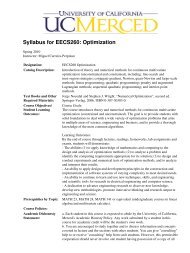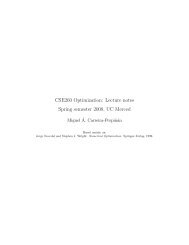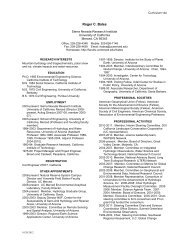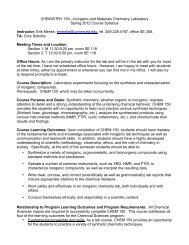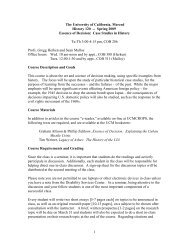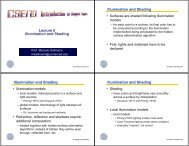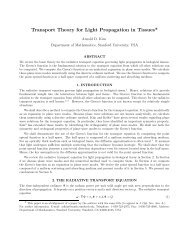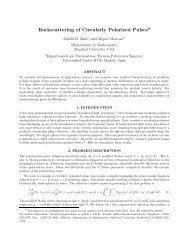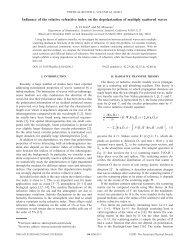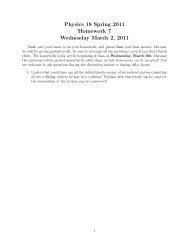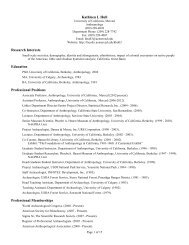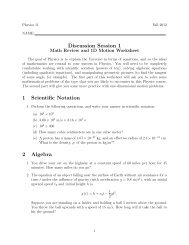Physics 9 Fall 2009
Physics 9 Fall 2009
Physics 9 Fall 2009
You also want an ePaper? Increase the reach of your titles
YUMPU automatically turns print PDFs into web optimized ePapers that Google loves.
<strong>Physics</strong> 9 <strong>Fall</strong> <strong>2009</strong><br />
Homework 1 - Solutions<br />
1. Chapter 26 - Exercise 6.<br />
What is the total charge of all the electrons in 1.0 L of liquid water?<br />
————————————————————————————————————<br />
Solution<br />
Remember that the density of water is 1 g/cm 3 . Since 1 cm 3 is 1 mL, one liter has<br />
1000 mL, then one liter of water has a mass of 1 kg. How many electrons are in one<br />
kilogram of water? Each water molecule has ten electrons, and each mole of water has<br />
a mass of 18 grams. So, one liter of water contains 1000/18 = 55.6 moles.<br />
Since one mole of objects contains 6.02 × 10 23 of those objects, the water has a total<br />
of 55.6 × 6.02 × 10 23 = 3.35 × 10 25 water molecules. Each of those molecules has ten<br />
electrons, giving a total 3.35 × 10 26 electrons in 1 kg of water. Each electron carries<br />
a charge of −1.602 × 10 −19 C. Thus, all of the electrons together give a charge of<br />
−1.602 × 10 −19 × 3.35 × 10 26 = −5.36 × 10 7 C.<br />
1
2. Chapter 26 - Exercise 13.<br />
Two 1.0 kg masses are 1.0 m apart (center to center) on a frictionless table. Each has<br />
+10 µC of charge.<br />
(a) What is the magnitude of the electric force on one of the masses?<br />
(b) What is the initial acceleration of this mass if it is released and allowed to move?<br />
————————————————————————————————————<br />
Solution<br />
(a) The force on one of the masses is identical to the force on the other, and is<br />
given by Coulomb’s law, F = 1<br />
4πɛ0<br />
(9 × 10 9 ) (10×10−6 ) 2<br />
1 2<br />
= 0.90 N.<br />
qQ<br />
r 2 ˆr. Plugging in the numbers gives F =<br />
(b) Newton tells us that F = ma, and so a = F/m. Dividing the force we found in<br />
part a by the mass of the object gives a = F/m = 0.9/1 = 0.9 m/s 2 .<br />
2
3. Chapter 26 - Exercise 21.<br />
The electric field at a point in space is <br />
E = 200î + 400ˆj N/C.<br />
(a) What is the electric force on a proton at this point? Give your answer in component<br />
form.<br />
(b) What is the electric force on an electron at this point? Give your answer in<br />
component form.<br />
(c) What is the magnitude of the proton’s acceleration?<br />
(d) What is the magnitude of the electron’s acceleration?<br />
————————————————————————————————————<br />
Solution<br />
(a) The electric force on a charge q in an electric field E is F = q E. The charge on the<br />
proton is q = +e = 1.602 × 10−19 , and so <br />
Fp = e 200î + 400ˆj = 3.2î + 6.4ˆj ×<br />
10 −17 N.<br />
(b) The electron carries an equal, but opposite, charge as does the proton. This just<br />
changes the sign of the force that we found in part a, giving <br />
Fe = − 3.2î + 6.4ˆj ×<br />
10 −17 N.<br />
(c) The magnitude of the acceleration is a = F/m =<br />
of 1.67 × 10 −27 kg. Thus, ap = Fp<br />
mp = √ 3.2 2 +6.4 2 ×10 −17<br />
1.67×10 −27<br />
√ F 2 x +F 2 y<br />
. The proton has a mass<br />
m<br />
= 4.28 × 10 10 m/s2 .<br />
(d) Here we just divide by the mass of the electron. Since it’s lighter, we expect the<br />
electron to have a bigger acceleration. ae = Fe<br />
me = √ 3.22 +6.42 ×10−17 9.11×10−31 = 7.85 × 1013 m/s2 . The electron does have a bigger acceleration, as expected.<br />
3
4. Chapter 26 - Exercise 25.<br />
What are the strength and direction of an electric field that will balance the weight of<br />
a 1.0 g plastic sphere that has been charged to -3.0 nC?<br />
————————————————————————————————————<br />
Solution<br />
Because the sphere is charged, it experiences an electric force, FE, when placed in an<br />
electric field. There is also a gravitational force FG acting on the sphere. When these<br />
forces are balanced, then FE = FG. The electric force is FE = qE, while FG = mg,<br />
and so<br />
E = mg<br />
q .<br />
Since the charge is negative, we see that the electric field has to point down so that<br />
the charge is repelled up. The magnitude of the force is<br />
E = mg<br />
q = 10−3 × 9.8<br />
3 × 10 −9 = 3.3 × 106 N/C.<br />
As we said, the direction is down, so we can write the full electric field as<br />
E = −3.3 × 10 6ˆj N/C,<br />
where ˆj points along the vertical direction.<br />
4
5. Chapter 26 - Problem 34.<br />
The nucleus of a 125 Xe atom (an isotope of the element xenon with mass 125 u) is 6.0<br />
fm in diameter. It has 54 protons and charge q = 54e.<br />
(a) What is the electric force on a proton 2.0 fm from the surface of the nucleus?<br />
(b) What is the electric force on an electron at this point? Give your answer in<br />
component form.<br />
(c) What is the proton’s acceleration?<br />
Hint: Treat the spherical nucleus as a point charge.<br />
————————————————————————————————————<br />
Solution<br />
(a) The electric force is given by Coulomb’s law, F = 1 qQ<br />
4πɛ0 r2 . What’s the distance,<br />
r? The proton is 2.0 fm from the surface, so r = 6/2 + 2 = 5 fm. Thus,<br />
F = 1 qQ<br />
4πɛ0 r2 = 9 × 109 (54) (1.602 × 10−19 ) 2<br />
(5 × 10−15 ) 2<br />
(b) The proton’s acceleration is just a = F/mp, so<br />
a = F<br />
mp<br />
This is a huge acceleration!<br />
=<br />
500<br />
1.67 × 10 −27 = 3.00 × 1029 m/s 2 .<br />
5<br />
= 500 N.
6. Chapter 26 - Problem 38.<br />
What is the force F on the 1.0 nC charge in the<br />
figure? Give your answer as a magnitude and direction.<br />
————————————————————————————————————<br />
Solution<br />
The net force on the 1.0 nC charge is the sum of the forces from each charge, Ftot =<br />
F2.0 + F−2.0. The force from the positive charge is<br />
F2.0<br />
1 qQ<br />
= 4πɛ0 r2 ˆr<br />
1 qQ<br />
=<br />
4πɛ0 r3 r<br />
= (9 × 109 ) (1×10−9 )(2×10−9 )<br />
(0.01) 3<br />
<br />
0.01 cos (60◦ ) î + .01 sin (60◦ ) ˆj<br />
= 0.9 × 10−4 √ <br />
î + 3ˆj N.<br />
The force from the negative charge is<br />
qQ<br />
r 2 ˆr<br />
F−2.0<br />
1<br />
= 4πɛ0<br />
= (9 × 109 ) (1×10−9 )(−2×10−9 )<br />
(0.01) 3<br />
<br />
−0.01 cos (60◦ ) î + .01 sin (60◦ ) ˆj<br />
= 0.9 × 10−4 √ <br />
î − 3ˆj N.<br />
So, the net force is Ftot = F2.0 + F−2.0 = 0.9 × 10−4 √ <br />
î + 3ˆj + 0.9 × 10−4 √ <br />
î − 3ˆj<br />
N, or Ftot = 1.8 × 10 −4 î N; the force is entirely in the x−direction.<br />
6
7. Chapter 26 - Problem 54.<br />
Suppose the magnitude of the proton charge differs from the magnitude of the electron<br />
charge by a mere 1 part in 10 9 .<br />
(a) What would be the force between two 2.0-mm-diameter copper spheres 1.0 cm<br />
apart? Assume that each copper atom has an equal number of electrons and<br />
protons.<br />
(b) Would this amount of force be detectable? What can you conclude from the fact<br />
that no such forces are observed?<br />
————————————————————————————————————<br />
Solution<br />
(a) For this problem we need to look up lots of properties of copper. The density of<br />
copper is ρ = 8920 kg/m 3 . So, the spheres have a mass of m = ρV = ρ 4<br />
3 πr3 =<br />
(8920) 4<br />
3 π (10−3 ) 3 = 3.736 × 10 −5 kg. Copper also has a molar mass of 63.5 g/mol,<br />
and so the spheres contain 0.03736/63.5 = 5.884 × 10 −4 moles. This means that<br />
they have a total of 5.884 × 10 −4 × 6.02 × 10 23 = 5.542 × 10 20 copper atoms.<br />
There are 29 electrons per atom, so the spheres have a total of 29 × 5.542 ×<br />
10 20 = 1.607 × 10 22 electrons. Thus, the total positive charge in each sphere is<br />
1.607 × 10 22 × 1.602 × 10 −19 = 2575 C.<br />
If the electrons had a difference in charge of 10 −9 , then it would give each sphere<br />
a net charge of 10 −9 × 2575 = 2.575 × 10 −6 C. From Coulomb’s law, the spheres<br />
would have a net force<br />
F = k Q2<br />
r 2 = 9 × 109 × (2.575 × 10−6 ) 2<br />
(10 −2 ) 2<br />
≈ 600 N<br />
(b) This is an easily measurable force! Since we don’t see these forces, this allows us<br />
to put limits on the difference in charge between the electron and proton.<br />
7
8. Chapter 26 - Problem 55.<br />
In a simple model of the hydrogen atom, the electron moves in a circular orbit of<br />
radius 0.053 nm around a stationary proton. How many revolutions per second does<br />
the electron make?<br />
————————————————————————————————————<br />
Solution<br />
The electric force holds the electron to the proton. Since it’s moving in a circle, there<br />
is also a centripetal force. The two forces are equal in magnitude, keeping the circular<br />
orbit stable. So, Felec = 1 e<br />
4πɛ0<br />
2<br />
r2 = mv2<br />
r = Fcent. Now, we can write v = rω, where ω is<br />
the angular frequency. The ordinary frequency is f = ω/2π. Thus, we can solve for<br />
the frequency to find<br />
Thus, ω 2 = 1<br />
4πɛ0<br />
1<br />
4πɛ0<br />
e2 mv2<br />
=<br />
r2 r<br />
e 2<br />
mr 3 , or since ω = 2πf,<br />
Plugging in the numbers gives<br />
f = 1<br />
<br />
2π<br />
1 e<br />
4πɛ0<br />
2<br />
<br />
1<br />
=<br />
mr3 2π<br />
(9 × 109 )<br />
f = 1<br />
<br />
2π<br />
= m<br />
r (rω)2 = mrω 2 .<br />
1<br />
4πɛ0<br />
e2 .<br />
mr3 (1.602 × 10 −19 ) 2<br />
9.11 × 10 −31 (0.053 × 10 −9 ) = 6.65×1015 rev/sec.<br />
8
9. Chapter 26 - Problem 75.<br />
The identical small spheres shown in the figure<br />
are charged to +100 nC and -100 nC. They hang<br />
as shown in a 100,000 N/C electric field. What is<br />
the mass of each sphere?<br />
————————————————————————————————————<br />
Solution<br />
The net force on the -100 nC charge is the sum<br />
of the forces from the positive charge, the electric<br />
field, and gravity! The freebody diagram for the<br />
negative charge is seen in the figure. Writing down<br />
the force equations gives<br />
Fx = FE − Fe − T cos (80 ◦ ) = 0<br />
Fy = T sin (80 ◦ ) − FG = 0.<br />
Solving for the tension in the Fy equation gives<br />
T = mg<br />
sin 80◦ , where we set FG = mg. Plugging this<br />
result back into the Fx equation gives<br />
FE − Fe = mg<br />
.<br />
tan 80◦ Now, FE = qE, while Fe = 1 qQ<br />
4πɛ0 r2 . Solving for m then gives<br />
m =<br />
q tan 80◦<br />
g<br />
<br />
E − 1<br />
4πɛ0<br />
Q<br />
r2 <br />
.<br />
From the geometry of the setup, the distance between the charges r = 2L sin 10◦ , where<br />
L = 50 cm is the length of the string. Plugging in all the numbers gives<br />
<br />
q tan 80◦<br />
m = E −<br />
g<br />
1 Q<br />
4πɛ0 r2 <br />
= 100 × 10−9 tan 80◦ <br />
10<br />
9.8<br />
5 − 9 × 10 9 100 × 10−9 sin2 10◦ <br />
.<br />
Evaluating the numbers we find m = 4.1 grams.<br />
9
10. Chapter 26 - Problem 77.<br />
In Section 26.3 we claimed that a charged object<br />
exerts a net attractive force on an electric<br />
dipole. Let’s investigate this. The figure to the<br />
left shows a permanent electric dipole consisting<br />
of charges +q and −q separated by the fixed distance<br />
s. Charge +Q is distance r from the center<br />
of the dipole. We’ll assume, as is usually the case<br />
in practice, that s ≪ r.<br />
(a) Write an expression for the net force exerted on the dipole by the by charge +Q.<br />
(b) Is this force toward +Q or away from +Q? Explain.<br />
(c) Use the binomial approximation (1 + x) −n ≈ 1 − nx if x ≪ 1 to show that your<br />
expression from part a can be written Fnet = 2KqQs/r 3 .<br />
(d) How can an electric force have an inverse-cube dependence? Doesn’t Coulomb’s<br />
law say that the electric force depends on the inverse square of the distance?<br />
Explain.<br />
————————————————————————————————————<br />
Solution<br />
(a) The net force from the charge comes from both the positive and the negative<br />
charges in the dipole. From the figure, the distance from q to Q is r + s/2, and<br />
so the force between these two charges is<br />
Qq<br />
Fpos = −k<br />
(r + s/2)<br />
where the force is negative because the two positive charges repel each other,<br />
pushing the dipole away. Similarly, since the negative charge in the dipole is a<br />
distance r − s/2 away from Q, and is attractive, the force on −q is<br />
Qq<br />
Fneg = k<br />
(r − s/2)<br />
Thus, the net force is Fpos + Fneg, or<br />
<br />
F<br />
1<br />
= kQq<br />
(r − s/2)<br />
2 −<br />
2 î,<br />
2 î.<br />
1<br />
(r + s/2) 2<br />
<br />
î.<br />
(b) Because r − s/2 < r + s/2, the first term is bigger, and so the force is to the right<br />
– it’s an attractive force.<br />
10
(c) Using the binomial expansion, (1 + x) −n ≈ 1 − nx, we can rewrite<br />
<br />
<br />
1<br />
(r−s/2) 2 1 −<br />
(r+s/2) 2 = 1<br />
r2 1<br />
(1−s/2r) 2 1 −<br />
(1+s/2r) 2<br />
1 ≈ r2 <br />
s s<br />
1 + − 1 + r 2<br />
2s<br />
=<br />
r3 .<br />
So, this means that F ≈ 2kQqs<br />
r3 î, and is attractive.<br />
(d) Coulomb’s law applies between point charges. This situation is different – we<br />
have entended charge distributions. The negative charge is partially screened by<br />
the positive charge in the dipole. So, the force isn’t as strong. The force drops<br />
to zero because the dipole looks neutral at large distances; the two charges nearly<br />
cancel each other out.<br />
11




